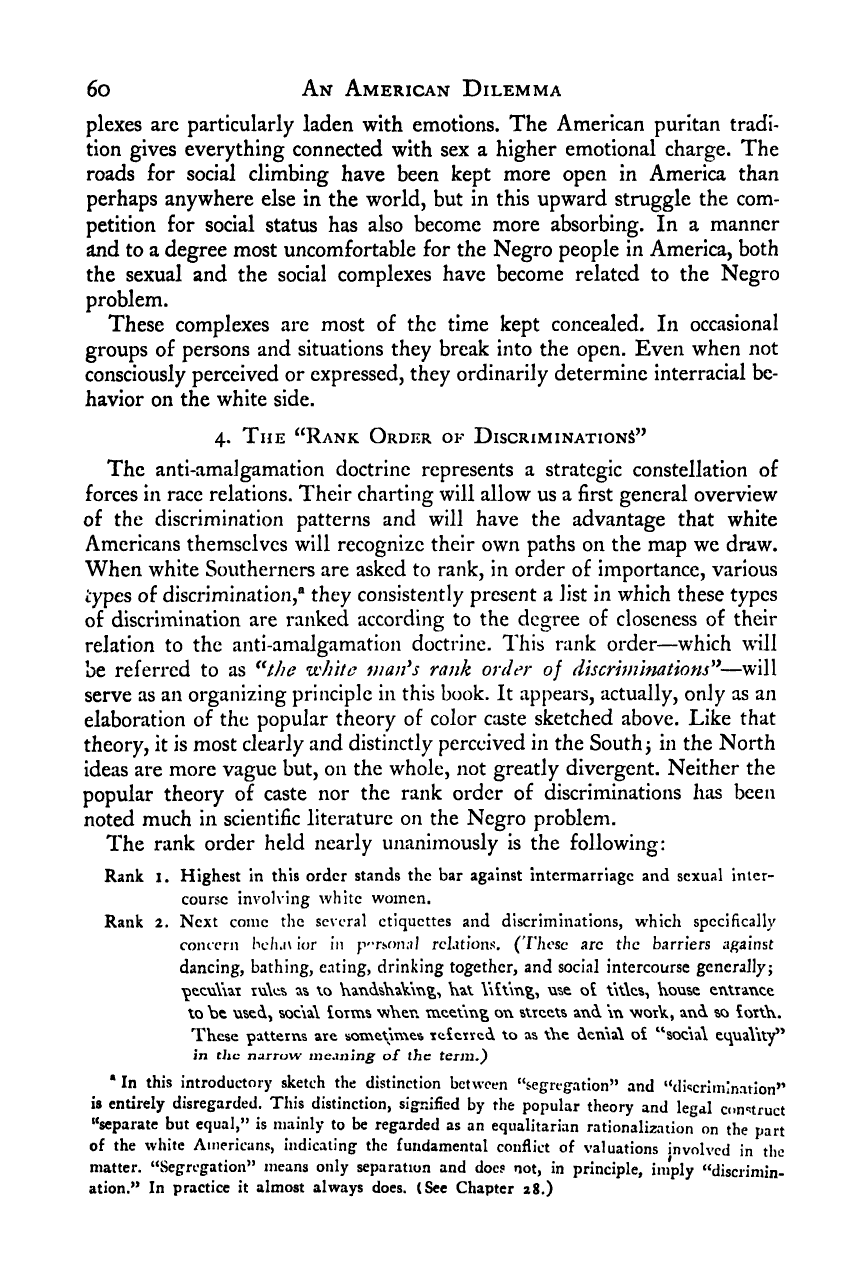Note: Gunnar Myrdal died in 1987, less than 70 years ago. Therefore, this work is protected by copyright, restricting your legal rights to reproduce it. However, you are welcome to view it on screen, as you do now. Read more about copyright.
Full resolution (TIFF) - On this page / på denna sida - I. The Approach - 3. Facets of the Negro Problem - 3. The White Man’s Theory of Color Caste - 4. The “Rank Order of Discriminations”

<< prev. page << föreg. sida << >> nästa sida >> next page >>
Below is the raw OCR text
from the above scanned image.
Do you see an error? Proofread the page now!
Här nedan syns maskintolkade texten från faksimilbilden ovan.
Ser du något fel? Korrekturläs sidan nu!
This page has never been proofread. / Denna sida har aldrig korrekturlästs.
6o An American Dilemma
plexes are particularly laden with emotions. The American puritan tradi-
tion gives everything connected with sex a higher emotional charge. The
roads for social climbing have been kept more open in America than
perhaps anywhere else in the world, but in this upward struggle the com-
petition for social status has also become more absorbing. In a manner
and to a degree most uncomfortable for the Negro people in America, both
the sexual and the social complexes have become related to the Negro
problem.
These complexes are most of the time kept concealed. In occasional
groups of persons and situations they break into the open. Even when not
consciously perceived or expressed, they ordinarily determine interracial be-
havior on the white side.
4. The “Rank Order of Discriminations’’
The anti-amaJgamation doctrine represents a strategic constellation of
forces in race relations. Their charting will allow us a first general overview
of the discrimination patterns and will have the advantage that white
Americans themselves will recognize their own paths on the map we draw.
When white Southerners are asked to rank, in order of importance, various
types of discrimination,® they consistently present a list in which these types
of discrimination are ranked according to the degree of closeness of their
relation to the anti-amalgamation doctrine. This rank order—which will
be referred to as ^Hhe white niaii^s rank order of discriminations ^^
—will
serve as an organizing principle in this book. It appears, actually, only as an
elaboration of the popular theory of color caste sketched above. Like that
theory, it is most clearly and distinctly perceived in the Souths in the North
Ideas are more vague but, on the whole, not greatly divergent. Neither the
popular theory of caste nor the rank order of discriminations has been
noted much in scientific literature on the Negro problem.
The rank order held nearly unanimously is the following:
Rank 1. Highest in this order stands the bar against intermarriage and sexual inicr-
coursc involving white women.
Rank 2. Next come the several etiquettes and discriminations, w^hich specifically
concern hc/ia\ ior in p’-rsonal relations, (These arc the barriers against
dancing, bathing, eating, drinking together, and social intercourse generally;
\o Wv ot house etvlTatvce
to be used, soc\a\ loims wheu tueeutv^ ou streets arvd \r\ worh, aud so ioith.
These patterrvs are someUmes reieired to as the deT\\a\ oi “social equality”
in the narrow meaning of the tern2,)
• In this introductory sketch the distinction between “segregation” and “discriiiilnation”
is entirely disregarded. This distinction, sig.nified by the popular theory and legal construct
“separate but equal,” is mainly to be regarded as an equalitarian rationalization on the part
of the white Americans, indicating the fundamental conflict of valuations involved in the
matter. “Segregation” means only separation and does not, in principle, imply “discrimin-
ation.” In practice it almost always does. (See Chapter 28.)
<< prev. page << föreg. sida << >> nästa sida >> next page >>